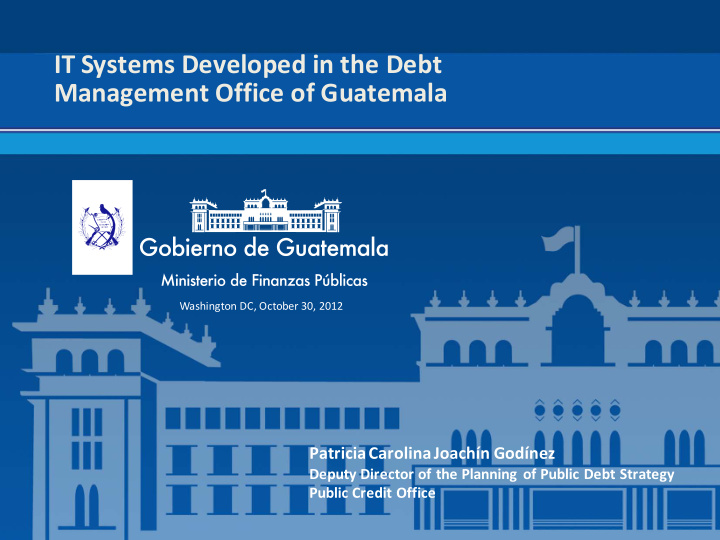



IT Systems Developed in the Debt Management Office of Guatemala Washington DC, October 30, 2012 Patricia Carolina Joachín Godínez Deputy Director of the Planning of Public Debt Strategy Public Credit Office For internal use only
Organizational Structure of the Debt Management Office in Guatemala • Congress • Legislation • Other institutions DEBT MANAGEMENT • Regulation • Functions • Procedures • Coordination MINISTRY OF FINANCE DEPUTY MINISTER OF FINANCIAL MANAGEMENT DEBT MANAGEMENT OFFICE LEGAL ADVICE IT SYSTEM TEAM FRONT OFFICE MIDDLE OFFICE BACK OFFICE DEBT AND RISK REGISTER, CONTROL AND LOAN MOBILIZATION AND MANAGEMENT PAYMENT OF DEBT MANAGEMENT
Types of debt that are managed PUBLIC DEBT EXTERNAL DOMESTIC by debtor by debtor Central Central Publicly Government Government Guaranteed Debt by creditor by creditor by creditor Official Official Private Public Private creditors creditors creditors creditors creditors Bonds Bonds Multilateral Eurobonds Bilateral
Implementation of IT Debt Systems • The Guatemalan Management Debt Office decided to install DMFAS 5.1 of 1999 UNCTAD, which is used for purposes of database operations and recording of external publicdebt. • SIADEP (Sistema de Administración de Deuda Pública Externa) was created as 2002 a link system between DMFAS and the national accounting system used by the government to manage the disbursements and servicingofexternal debt. 2003- • There was a transition in SIADEP from a client server version to a WEB platform 2005 tookplace, in order to improve the availability, access and updatingoftools. • Subsequently, SITVAL ( Sistema de Títulos Valores) was implemented to 2006 maintain a statistical records and internal debt payments registry. This system is in constant development. • DMFAS, SIADEP and SITVAL were called SINADEP ( Sistema Nacional de la 2010 Deuda Pública) , which contains the information related with the country´s publiccredit. • The Credit Public Direction implemented DMFAS, version 6.0, which includes In late analytical functions, that allow the generation of financial indicators of the 2011 current external debt portfolio and sensitivityanalysis.
IT Systems of Public Debt in Guatemala SINADEP DMFAS SIADEP SITVAL
Products Generated by IT Systems • Disbursement arrangements and payment of debt service. • Production of multiannual public debt projections. • Public debt statistics, that can be consulted at the WEB site of the Ministry of Finance (http://http://www.minfin.gob.gt/dcp_estadisticas .html/ ) • Appropriate reports upon users demand on stocks and public debt flows. • Financial indicators of the current external debt and sensivity analysis.
SINADEP Screen
SINADEP Reports: that can be consulted at the WEB site http://www.minfin.gob.gt/dcp_estadisticas.html
DMFAS Screen on analytic functions
Interaction of IT Systems with the Middle Office Reliableand timely debt data for MIDDLE elaboration of goverment debt OFFICE strategy FRONT & Statistics & Reporting SIADEP & SITVAL MIDDLE OFFICE Databaseoperations & recording BACK SITVAL, DMFAS & OFFICE SIADEP
Steps to follow: Preparing the debt data for Government Debt Strategy Implementing of Sistema de Información para Diseño de Estrategia de Deuda (SISDED) Data export projected flows of SISDED Informationintegrationof existing debt stocks and projected flows Classificationand grouping of stylized instruments Aggregation of stylized instruments to MTDS toolkit.
Benefits and risks of having built a hybrid system Benefits: • To maintainthe particularitiesof every debt type. • Generation of electronic payment and disbursements instructions for recording at the accountingsystem. • Generatefriendly reports upon user demands. • Easyconvertibilityof payment currencies into local currency. • Easy adaptation to new debt instruments and to changes of the existent ones, at low cost and less time, as an appropriatetechnologicalteam alreadyexists. Risk: • Operativerisk when hadlinginformation of database. • Increased time spent for the integration of domestic with external debt for analysisand specializedprocesses. • Bigger investment of resources in adapting the systems to technological changes.
I am very grateful for your attentions!
Recommend
More recommend